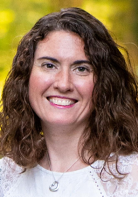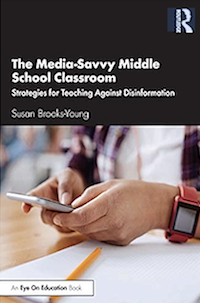Strategies for Teaching Against Disinformation
The Media-Savvy Middle School Classroom: Strategies for Teaching Against Disinformation
By Susan Brooks-Young
(Routledge/Eye On Education, 2021 – Learn more)
Reviewed by Megan Balduf

Brooks-Young’s slim volume packs a punch, covering a range of topics in under 100 pages. It’s a great text for those looking for a theoretical foundation on why media literacy is important and what some issues with disinformation are.
However, despite the promise of strategies that can be easily slotted into class, Brooks-Young’s suggested lessons felt more like material for a stand-alone media literacy class than something teachers could quickly adapt to their current practices.
Lessons for selected facets of media literacy

Brooks-Young provides strategies to handle ten different concerns:
- Accurate quotation attribution
- Expertise
- Echo chambers
- Fact versus fiction
- Sharing information
- Statistics
- Averages
- Question-framing on surveys
- Data visualization
- Probability
For each skill, Brooks-Young provides a lesson plan aligned to Common Core State Standards. In laying out her book with the topics above, her intent is to link the first five to ELA or social studies classes while the latter are adaptable for mathematics courses.
Beyond the typical middle schooler
Despite the time I invest in my own classroom for media literacy education, I found some of Brooks-Young’s skills too esoteric for what I do (and thus far too theoretical for a typical middle school classroom that may barely scratch the surface of media literacy). For instance, as interesting as I find informantion about how surveys are written and the way our biases may play into how questions and responses are written, my bigger concern is that my students recognize bias in general.
I would rather put my time and energy into teaching students what bias is and how it colors what they see – and thus how they can potentially combat it – than focus so intently on how questions on a survey might be written to provide an intentionally biased outcome.
How the lessons are structured
The lesson plans for each skill are less full-lesson than outline, which works for the context. Brooks-Young provides background on the how and why of the plan, providing clear objectives and connections to Common Core standards. Each plan has a set-up and explanation of the activity itself as well as an ending/extension.
Several plans also have options for modification. With each plan, however, I felt they assumed a greater level of prior knowledge or experience with media literacy than most students typically have. Additionally, the time range provided would nearly need to be doubled in situations where students have had little exposure to media literacy.
Overall, the premise behind making sure middle school students are media-savvy is critically important in a world where information is presented in so many ways, by so many voices, and consumed across many different forms of media. Yet I wish I was able to fold more of Brooks-Young’s work into my instructional practice. It’s supported by solid theory, but the practical implications fell short of what I believe would work in most middle school classrooms.
References
National Association for Media Literacy Education. SNAPSHOT 2019: The State of Media Literacy Education in the U.S. NAMLE, 2019, https://namle.net/wp-content/uploads/2020/10/SOML_FINAL.pdf.
Megan Balduf (@MBalduf) is a public middle school English teacher with nineteen years’ experience. Being a classroom teacher was always her dream, and her experience combined with a passion for always striving for better helped Megan become a teacher leader in her building, in her school system, and with roles in national organizations. Since entering the classroom, Megan has earned an MA in Gifted Education, and an MA in English for Language Arts Teachers, and has become a National Board Certified Teacher.



































